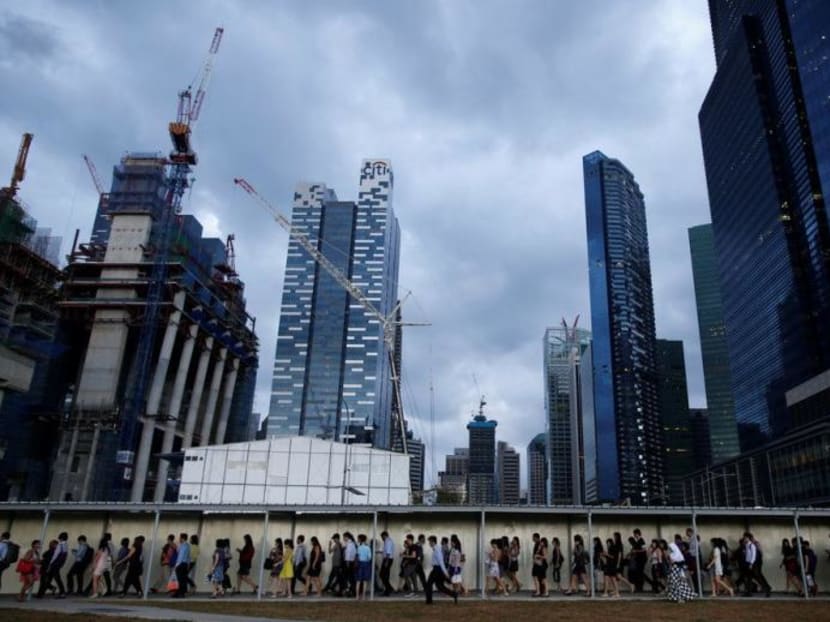Labour market improves in first half of 2018; job vacancies at 3-year high
SINGAPORE — Job vacancies hit a three-year high in June, while retrenchments declined and total employment grew in the first half of this year, the Ministry of Manpower (MOM) reported on Thursday (Sept 13) as it released the labour market report for the second quarter (Q2).

Although the resident unemployment rate edged up to 2.9 per cent in Q2 from the previous quarter’s 2.8 per cent, it was lower than a year ago.
SINGAPORE — Job vacancies hit a three-year high in June, while retrenchments declined and total employment grew in the first half of this year, the Ministry of Manpower (MOM) reported on Thursday (Sept 13) as it released the labour market report for the second quarter (Q2).
Although the resident unemployment rate edged up to 2.9 per cent in Q2 from the previous quarter’s 2.8 per cent, it was lower than a year ago.
The long-term unemployment rate also inched up to a seasonally adjusted rate of 0.8 per cent (up from 0.7 per cent the previous quarter) but was within the range seen in the last two years.
The labour market continued to improve in the first half of the year, said the MOM in a statement.
JOBS-SKILLS MISMATCHES WILL CONTINUE TO BE A CHALLENGE
Even so, it cautioned: “As restructuring picks up pace amidst increased economic activity, jobs and skills mismatches will continue to be a challenge. It will therefore be increasingly important for workers and businesses to stay agile and responsive to economic transformation and an evolving workforce landscape.”
Job vacancies rose to a three-year high of 56,700 in June this year, up from 53,900 in March.
As the increase in unemployed persons was relatively smaller, the number of seasonally adjusted job vacancies increased to 108 per 100 unemployed persons, up from 104 in March.
Despite this, the seasonally adjusted resident unemployment rate rose to 2.9 per cent in June because more people entered the labour force to look for work, “in line with the pick-up in economic activities”, said the MOM.
By age, the unemployment rate among residents aged 30 and below saw a “discernible decline” after trending up in the last two years.
By education, the unemployment rate rose and was above-average for residents with post-secondary, diploma and professional qualifications.
GROWTH IN COMMUNITY AND INFOCOMMS SECTORS
There were 5,350 retrenchments in the first half of the year – lower than the 7,640 in the first half of last year. However, more were retrenched in Q2 than the first quarter, “largely due to reorganisation and restructuring”, the MOM said.
The number of locals in employment grew by 6,500 in the first half of the year, more than 1.5 times the growth of 4,000 in the first half of last year.
Total employment (excluding foreign domestic workers) as of June was 3,429,600.
Growth occurred mainly in the community, social and personal services sector, the financial and insurance services sector, the information and communications sector, and the transportation and storage sectors.
Foreign employment grew slightly by 400 in the first half of the year, compared to a significant decline of 21,400 in the same period last year. The modest growth was due to a more modest decline in the construction sector and stronger growth in the services sector.
In the second half of the year, the MOM said it expects labour demand to pick up in line with seasonal hiring seen previously.
Hiring will likely remain cautious in sectors such as construction and marine shipyard. But job opportunities will continue to be available in information and communications, financial and insurance services, healthcare, professional services, wholesale trade and the built environment sectors.
Labour supply in the medium term will remain tight, said the ministry.
The MOM and Workforce Singapore will press on with efforts to prepare workers and businesses for changes in the economy and labour market, such as through more professional conversion programmes that will equip workers for new roles and functions, and will retrain workers even before they are displaced.








